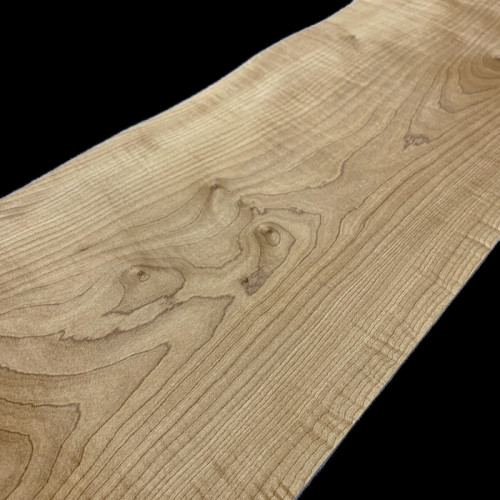
Fumed Sycamore Veneers 265 x 32 cm
Fumed Sycamore Veneers 265 x 32 cm
Genuine wood sliced-veneer sheets, in matched sequence.
Length: 265 cm.
Width: 32 cm.
Thickness: 0.6 mm.
Sold by the sheet.
These photos are taken from the veneer sheets you will receive.
Fumed Sycamore Veneers 265 x 32 cm
Genuine wood sliced-veneer sheets.
Fumed veneers are sheets of wood exposed to a tannin-reactive agent to achieve a particular color. This treatment allows to modify the natural color of the wood, depending on its tannin content.
This content varies from one tree to another, which explains why the colors of fumed veneers can vary from one log to another.
In the case of Sycamore, fuming gives the wood a color close to that of gold, which is even more surprising with a high-gloss varnish.
Dimensions:
Length: 265 cm.
Width: 32 cm.
Thickness: 0.6 mm.
Measurement scaling:
Dimensions are measured at the small end.
- Width rounded to the covered centimeter: 15.8, giving 15 cm.
- Length rounded to 5 centimeters: 257, giving 255 cm.
Species:
Botanic name: Acer Pseudoplatanus.
Common name: European Sycamore, European Maple, Sycamore.
The Sycamore maple, or the European maple, is a hardwood called "white," but its color is slightly ivory.
Unlike its cousin, the North American maple, it does not have sugar hair. On the other hand, the Sycamore has small wood-colored pinknots; these pinknots are inevitable. Therefore, a Sycamore long veneer without pinknots is extremely rare.
This forest species is one of the valuable hardwoods, especially in its figured form.
Sycamore is mainly used in cabinetmaking and decoration.
Figured Sycamore is best known for its use in violin and cello Lutherie; Figured Sycamore is so involved in violin production that when a Sycomore is strongly figured, it takes the name of "Fiddled-back Sycamore."
This figured wood has a unique aestheticism and a much sought-after tone for violins and cellos.
Figured Sycamore is a rare and precious wood.
Sycamore is called "Plain" when it is not Figured. However, the Plain Sycamore can have some flames here and there, and it can also have a very light figure called "Shadow figure," which is not marked enough to be considered a figured wood.
Veneer Product Description:
Genuine wood-sliced veneer sheets.
These veneers are raw without a finish or any fleece back.
The veneer surface is similar to plane wood. However, it will be preferable to forecast a light sanding after gluing.
The veneers are offered here as wood-sliced sheets of one and unique thickness.
Both faces of these veneers are the same, without fleece back or glue.
Even if the veneer's sides had been cut relatively straight, it isn't a precise parallel clipping; some veneers may have kept the decreasing shape of the tree, wider at the bottom end and narrower at the top end.
Very occasionally, some veneer's sides have traces of unclipped wane, but our veneers are measured at the narrowest, as explained in the paragraph "Dimensions."
As genuine natural wood, all finishing products are acceptable as long these products are meant to be used for wood.
The choice of the finished product must be consistent with the final usage realization.
Utilization:
Cutting:
Veneers can be easily cut with a utility knife.
For straight cuts, the best results are obtained with a veneer saw.
Use a fretsaw, scalpel, or veneer knife for curved cuts.
Always allow for a slightly larger veneer sheet than your intended surface. This will allow you to adjust the size after gluing for a clean finish.
A flush trimmer can also be used to trim the veneer after gluing.
When cutting with a utility knife or veneer knife, it is best to cut with the grain of the wood. To check this, run your finger along the edge of the sheet. The direction that feels smoothest is the ideal direction for cutting.
Gluing:
Several types of gluing are possible.
With vinylic glue, the veneer is pressed over its entire surface.
With neoprene glue, apply two coats of glue and marouflage for all surfaces, especially non-porous surfaces.
With animal glue such as hide, sinew, or bone glue.
With vinyl glue and an iron, apply two thin coats of glue to each piece. This technique should only be used if other gluing techniques are not possible.
Sanding:
Veneers and all our products are wood and can be sanded according to their thickness.
Regardless of the thickness of the veneer, please do not use a belt sander, as this could pierce it.
With a 0.6 mm veneer, lightly sand with 120 grit and then finish with 180 or 240 grit. With an orbital sander, 180 grit is already sufficient for most applications.
Finishing:
All finishing products generally used for wood are suitable for finishing our products. For example, you can use a varnish, wax, paint, or oil.
However, ensure that the product you want to use is compatible with the final use of your creation.
Look at our TUTORIALS, and you might find some valuable tips.
Pictures:
Pictures herewith are actual photos of the product you will receive.
For presentation, the veneer sheets may have been juxtaposed to give you a better idea of the final aspect after splicing; this is only a suggestion; display it as you wish.
Packing:
Veneers are rolled and well protected in a strong cardboard box chosen for resisting somewhat vigorous handling and delivered to you in good condition.
Prices:
Sold by the sheet, decreasing prices upon quantity.
More info:
Should you need more info, please get in touch with us either by e-mail or by telephone.
Data sheet
- Species
- Sycamore
- Thickness group
- Standard
- Width group
- XXL width
- Grade
- Crown-cut
Fumed
You might also like
 English
English






